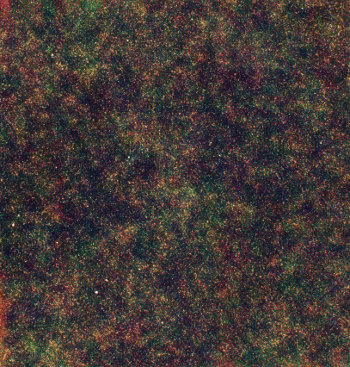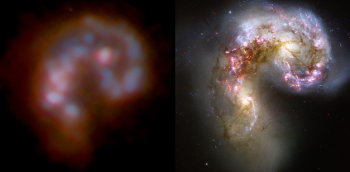
Image of the distant Universe as seen by Herschel’s SPIRE instrument. Every small spot of light is a distant galaxy, seen between 10 and 12 billion years ago. On close examination, the distribution is not uniform, with some containing more galaxies than others.
Credit: ESA / SPIRE and HerMES consortia.

The Antennae Galaxies as seen in the far-infrared by Herschel (left), and in visible light by the Hubble Space Telescope (right). The areas with most star formation are bright in the Herschel image, but hidden by dust in the Hubble image.
Credit: ESA / PACS / SHINING / U. Klaas & M. Nielbock, MPIA.
Bright galaxies like to stick together
26 May 2010
Astronomers using the European Space Agency's Herschel telescope have discovered that the brightest galaxies tend to be in the busiest parts of the Universe. This crucial piece of information will enable theorists to improve their theories of galaxy formation.
For over a decade, astronomers have been puzzled by some strange, bright galaxies in the distant Universe which appear to be forming stars at phenomenal rates, making them very hard to explain with conventional theories of galaxy formation. One important question has been the environments in which they are located, such as how close together they are. The Herschel Space Observatory, with its ability for very sensitive mapping over wide areas, has been able to see thousands of these galaxies and identify their location, showing for the first time that they are packed closely together in the centre of large galaxy clusters.
A project using the UK-led SPIRE instrument on board Herschel has been surveying large areas of the sky, currently totalling 15 square degrees – around 60 times the size of the Full Moon. The two regions mapped so far are in the constellations of Ursa Major and Draco, well away from the confusion of our own Galaxy. Galaxies which are brightest at Herschel’s far-infrared wavelengths are typically seen as they were around 10 billion years ago, the light having been travelling towards us since then.
The first image shows a false-colour view of a small portion of the sky observed by Herschel. Almost every point of light is an entire galaxy, each containing billions of stars. The colours represent the far-infrared wavelengths measured by Herschel, with redder galaxies either being further away or containing colder dust, while brighter galaxies are forming stars more vigorously. While at first glance the galaxies look to be scattered randomly over the image, in fact they are not. A closer look will reveals that there are regions which have more galaxies in, and regions that have fewer. This clustering of galaxies through space provides information about the way they have interacted over the history of the Universe.
Herschel sees material that cannot be seen at visible wavelengths, namely cold gas and dust between the stars. This is well illustrated by looking at much closer galaxies, which can be seen in more detail. The Antennae Galaxies, lying a mere 50 million light years away, are actually two galaxies which are in the process of colliding. Herschel does not see the light from stars, but the clouds of dust within which new stars are forming. The collision of these galaxies has caused a surge in star formation, but such collisions are relatively rare in the Universe today. Billions of years ago, however, when galaxies were much more tightly packed, such events were much more common.
Despite the new window on the Universe afforded by the far-infrared light, Herschel is still not seeing the full picture. Three quarters of the matter in our Universe is made up of mysterious “dark matter”, which does not shine at all. Since we cannot see dark matter, we do not yet know what it is made of, but we can measure its effect on the matter around it. Although it does not emit or absorb light, dark matter does interact with the rest of the Universe through gravity, gradually pulling groups of galaxies together into huge clusters over the course of billions of years. While many computer simulations exist of how this occurs, the ability to measure this at different times through the history of the Universe allows astronomers to compare the simulations with real measurements.
These latest results from Herschel, part of the "HerMES" key programme, have shown that the bright galaxies detected with the SPIRE instrument preferentially occupy regions of the Universe that contain more dark matter. This seems to be especially true about 10 billion years ago, when these galaxies were forming stars at a much higher rate than most galaxies are today.
Our Galaxy, the Milky Way, resides on the suburbs of a large supercluster centred about 60 million light years away. The neighbouring supercluster of galaxies to us is around 300 million light years away. By comparison, 10 billion years ago galaxies were only 20 to 30 million light years apart on average. Their proximity means that many of the galaxies will eventually collide with one another. It is these collisions that stirs up the gas and dust in the galaxies and causes the rapid bouts of star formation.
Professor Asantha Cooray, of the University of Califonia, is one of the HerMES astronomers leading this investigation, and he commented on the latest HerMES results:
"Thanks to the superb resolution and sensitivity of the SPIRE instrument on Herschel, we managed to map in detail the spatial distribution of massively starforming galaxies in the early universe. All indications are that these galaxies are busy. They are crashing, merging, and possibly settling down at centres of large dark matter halos."
It has required the sensitivity and resolution of Herschel to be able to identify the brightest galaxies and establish the way in which they are clustering. Dr Lingyu Wang, of the University of Sussex, said
"We have known for a long time that environment plays an important role in shaping galaxies' evolution. With Herschel, we are able to pierce through huge amounts of dust and study the impact of the environment right from the birth of these massive galaxies forming stars at colossal rates. This is allowing us to witness the active past of today's dead elliptical galaxies at times when they were in rich environments."
Prof Seb Oliver, of the University of Sussex, who leads the HerMES project, presented this result last week at the Herschel First Results Symposium in the Netherlands. Professor Oliver said
"This result from Asantha's team is fantastic, it is just the kind of thing we were hoping for from Herschel and was only possible because we can see so many thousands of galaxies, it will certainly give the theoretician's something to chew over".
This work, conducted as part of the Herschel Multi-tiered Extragalactic Survey (HerMES) Key Project of the Herschel mission, will be published in the international science journal "Astronomy & Astrophysics" in a special issue dedicated to the first science results from Herschel. The project will continue to collect more images over larger areas of the sky in order to build up a more complete picture of how galaxies have evolved and interacted over the past 10 billion years.
Further information
Since launch on 14th May 2009, Herschel spent several months undergoing careful tests on the performance of the instruments and calibration. This was followed by the Science Demonstration Phase: the period when the instruments were tested to their full capabilities.
To date, the mission has gone almost perfectly. The performance of the spacecraft has been shown to be well within pre-launch expectations, all three instruments are working extremely reliably, and the data from the Science Demonstration Phase is exceedingly promising. Herschel is now in a routine science phase, and will continue observing until its liquid helium coolant runs out in around two and half years. The results of the science demonstration phase were presented at the Herschel First Results Symposium in May 2010, and will be published in a Herschel Special Issue of the international scientific journal Astronomy and Astrophysics.
UK Participation in Herschel
The UK contribution to Herschel includes leadership of the international consortium that designed and built the SPIRE instrument. The UK SPIRE team is also responsible for the development of software for instrument control and processing of the scientific data, and leads the in-flight testing and operation of SPIRE. The Herschel programme in the UK is funded by the Science and Technology Facilities Council.
SPIRE comprises a three band imaging photometer and an imaging Fourier transform spectrometer and has been designed and built by a consortium of institutes including a number from the UK (Cardiff University; Imperial College, London; University College London’s Mullard Space Science Laboratory; the University of Sussex; and STFC’s Rutherford Appleton Laboratory and UK Astronomy Technology Centre). The UK is also leading the development of software for controlling the instrument from the ground and processing the data to produce scientific results. The SPIRE Operations Centre, responsible for delivering all instrument software to ESA, and for day-to-day instrument monitoring, operation, and calibration, is located at the Rutherford Appleton Laboratory with contributions from the Imperial College and Cardiff groups. The UK SPIRE institutes, together with astronomers in many other UK universities, are also strongly involved in the Herschel scientific programmes which have already been selected for the first 18 months of Herschel observations, and cover a wide range of science topics from our own solar system to the most distant galaxies.
Dr Bruno Maffei of the Jodrell Bank Centre for Astrophysics (JBCA) is part of the HerMES key programme. He was involved in the design and test of the SPIRE instrument on Herschel when working at Cardiff University, more specifically on the detector test and selection. He is now working at the University of Manchester on the development of instrumentation for future far-infrared to radio astronomical experiments within the Radio Astronomy Technology Group at JBCA.
Contacts
Dr Chris North
UK Herschel Outreach Officer
Cardiff University
Email: chris.north [@] astro.cf.ac.uk
Julia Short
Press Officer
STFC and UKSA
Email: Julia.short [@] stfc.ac.uk
Prof Seb Oliver
University of Sussex, UK
Email: s.oliver [@] sussex.ac.uk
Prof Asantha Cooray
University of California, Irvine, USA
Email: asante [@] caltech.edu
Dr Bruno Maffei
University of Manchester, UK
Email: bruno.maffei [@] manchester.ac.uk


